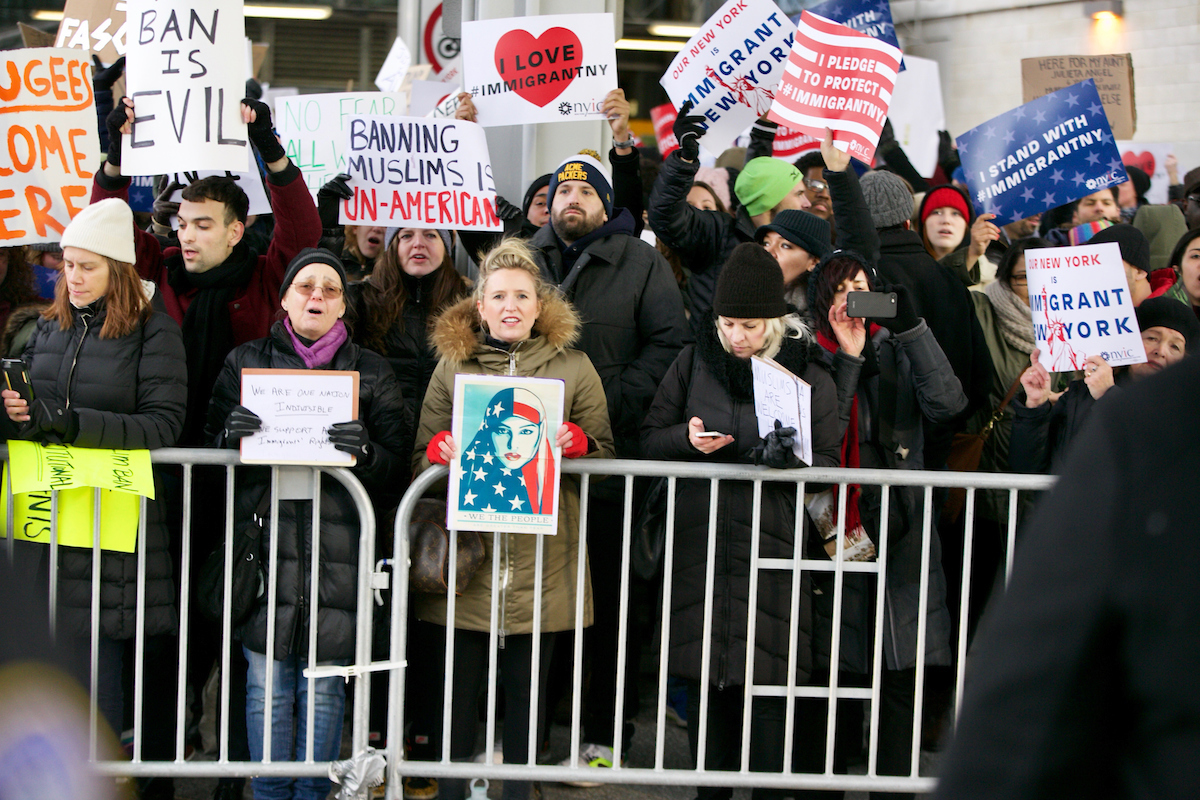Download a PDF Version
President Biden should be commended for rescinding the Muslim Ban on his first day in office. However, that is a step that could be easily reversed by a successor administration. Congress must clarify that the President does not have a blank check to discriminate on the basis of religious background or national origin. The NO BAN Act (H.R. 1333) would rectify fatal flaws within the INA that have allowed the Muslim Ban, and other discriminatory immigration orders, to be implemented. The NO BAN Act, which currently has 137 original sponsors, is the best way to prevent future Presidents from violating civil rights and abusing their authority as well as ensuring that Congress is able to conduct the necessary oversight to prevent abuses.
The President’s Broad Latitude to Discriminate
The previous administration’s Muslim ban survived judicial review largely due to a favorable interpretation of the 1965 Immigration and Nationality Act (INA), which provides the President with the authority to limit the entry of aliens. In the majority opinion of the Supreme Court case, Chief Justice Roberts stated that “the President has lawfully exercised the broad discretion granted to him under [the Immigration and Nationality Act] to suspend the entry of aliens into the United States.”
In so doing, the Court ignored a clear track record of discriminatory intent from the former President as well as numerous legal protections – under both the Constitution and a separate provision of the INA – against discrimination. In her dissenting opinion, Justice Sotomayor said that the majority was “ignoring the facts, misconstruing our legal precedent, and turning a blind eye to the pain and suffering the Proclamation inflicts upon countless families and individuals, many of whom are United States citizens.” Tens of thousands of individuals were barred by the ban every year for no reason other than the former President’s bigotry. We must act now to ensure that it does not happen again.
The Immigration & Nationality Act and the Muslim Ban
- The INA, passed in 1965, contains a broad, exclusionary provision in Section 212(f) that the Trump administration used to justify numerous discriminatory policies.
- Section 212(f) states that the President may “suspend the entry of all aliens or any class of aliens” whenever he or she determines their entry to be “detrimental to the interests of the United States.”
- The original intent of the INA was to do away with the quota system and to usher in a new era of non-discrimination in our immigration system. It included language that barred discrimination on the basis of race, sex, nationality, and place of residence, but not religion. The Supreme Court, in its decision that ultimately upheld the ban, implemented a much broader interpretation of the 212(f) statue that has now endowed the Presidency with near-unfettered authority in its immigration policy.
- The previous administration used this broadly worded, 54-year old statute, to ban individuals from seven Muslim-majority countries and restrict healthcare for immigrants. While the latter two policies were held up in the courts, the Trump administration’s legal justifications for both rested once again on the INA and its 212(f) provision.
The NO BAN Act: Fixing the INA
- The NO BAN Act achieves two goals: 1) puts in place sorely-needed safeguards around the President’s authorities currently enshrined in the INA; and 2) creates necessary oversight mechanisms to ensure Congress can act against discriminatory bans.
- In the INA’s current form, the 212(f) statute does not codify what factors determine whether an aliens’ entry is “detrimental” to U.S. interests, what restrictions are “appropriate,” and how long those restrictions should last. These gaps provide broad latitude to a President to mask discriminatory actions under Executive privilege, as Trump did.
- The NO BAN Act would remedy these gaps by curtailing the broad and unspecific language in the current law and by requiring the government to meet a more stringent standard in suspending or restricting entry based on “credible facts” and connected to “specific acts” that have actually occurred.
- With the NO BAN Act, Congress would also be routinely notified and briefed on the status, implementation, and legal authority for the executive’s actions. It would also expand the INA’s anti-discrimination language by specifically prohibiting religious-based discrimination.
- The NO BAN Act provides greater avenues for oversight by Congress on the use of such authorities in order to hold administrations accountable.
- The legislation would still allow the President to respond to imminent threats such as pandemics and other events that are legitimate threats to public health and safety, but it guards against blanket bans on ethnic, religious, and country-specific groups.
- Moreover, even prior to the ban, immigrants wishing to come to the United States already went through one of the most exhaustive vetting processes in the world. This system has proven to be remarkably effective for the government’s counterterrorism policies and does not need a bigoted, discriminatory ban to undermine the system.
Without the NO BAN Act, future Presidents will have blank checks to ban entire nations from the United States with little Congressional oversight and little remaining legal recourse for affected communities. With the NO BAN Act, future administrations would have to meet stringent criteria tied to facts in order to institute bans, while both Congress and affected communities would have substantial recourse to step-in in the event of a discriminatory order. The choice is clear: Congress must pass the NO BAN Act.
Additional Resources
- National Iranian American Council (NIAC) – Discriminatory Nature of the Ban
- National Immigration Law Center (NILC) – FAQ: The No Ban Act
- American Civil Liberties Union (ACLU) – Congressional Action to End the Bans
- Congressional Research Service – Executive Authority to Exclude Aliens: In Brief
- The Supreme Court of the United States: Trump v. Hawaii
The NO BAN Act How to Stop Future Abuses of the Immigration and Nationality Act
